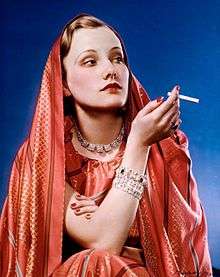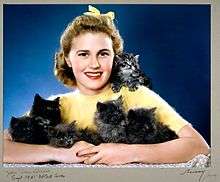Nickolas Muray



Nickolas Muray (born Miklós Mandl[1] 15 February 1892, Szeged – 2 November 1965, New York City) was a Hungarian-born American photographer and Olympic fencer.
Biography
Muray attended a graphic arts school in Budapest, where he studied lithography, photoengraving, and photography. After earning an International Engraver's Certificate, Muray took a three-year course in color photoengraving in Berlin, where, among other things, he learned to make color filters. At the end of his course he went to work for the publishing company Ullstein. In 1913, with the threat of war in Europe, Muray sailed to New York City, and was able to find work as a color printer in Brooklyn.
By 1920, Muray had opened a portrait studio at his home in Greenwich Village, while still working at his union job as an engraver. In 1921 he received a commission from Harper's Bazaar to do a portrait of the Broadway actress Florence Reed; soon after he was having photographs published each month in Harper's Bazaar, and was able to give up his engraving job. In 1922 he also made a portrait of the dancer Desha Delteil. Muray quickly became recognized as an important portrait photographer, and his subjects included most of the celebrities of New York City. In 1926, Vanity Fair sent Muray to London, Paris, and Berlin to photograph celebrities, and in 1929 hired him to photograph movie stars in Hollywood. He also did fashion and advertising work. Muray's images were published in many other publications, including Vogue, Ladies' Home Journal, and The New York Times.
Muray competed for the United States at the 1928 and 1932 Summer Olympics in the sabre fencing events.[2] Muray represented the New York Athletic Club and was a lifelong fencer for the club. He suffered a heart attack four years prior to his death while fencing at the club and was saved through the efforts of a fellow fencer and physician who performed open heart massage. On the second occasion in the very same fencing room Muray was struck again in a final and fatal attack. There is a plaque in his honor on display at the fencing room dedicated to his memory.
Between 1920 and 1940, Nickolas Muray made over 10,000 portraits. His 1938's portrait of Frida Kahlo, made while Kahlo sojourned in New York, attending her exhibit at the Julien Levy Gallery, became the best known and loved portrait made by Muray . Muray and Kahlo were at the height of a ten-year love affair in 1939 when the portrait was made. Their affair had started in 1931, after Muray was divorced from his second wife and shortly after Kahlo's marriage to Mexican muralist painter Diego Rivera. It outlived Muray's third marriage and Kahlo's divorce and remarriage to Rivera by one year, ending in 1941. Muray wanted to marry, but when it became apparent that Kahlo wanted Muray as a lover, not a husband, Muray took his leave for good and married his fourth wife, Peggy Muray.[3] He and Kahlo remained good friends until her death, in 1954.
After the market crash, Muray turned away from celebrity and theatrical portraiture, and become a pioneering commercial photographer, famous for his creation of many of the conventions of color advertising.[4] He was considered the master of the three-color carbro process.[4] His last important public portraits were of Dwight David Eisenhower in the 1950s.
References
- ↑ "Nyugati Hírlevél 109. szám, 2008. március 1". Epa.oszk.hu. Retrieved 2012-08-19.
- ↑ "Nickolas Muray Olympic Results". sports-reference.com. Retrieved 2010-05-01.
- ↑ Nickolas Muray papers, 1911-1978, Archives of American Art, Smithsonian Institution
- 1 2 "Nickolas Muray on Flickr Commons". Flickr.com. 2008-12-20. Retrieved 2012-08-19.
External links
| Wikimedia Commons has media related to Nickolas Muray. |
- Frida Kahlo images on the Nickolas Muray site
- Nickolas Muray gallery by George Eastman House
- A stamp with the Ivan Mestrovic portrait by Nickolas Muray
